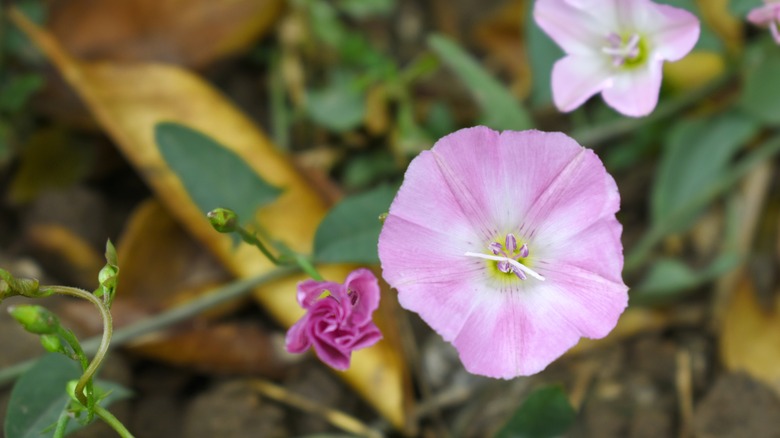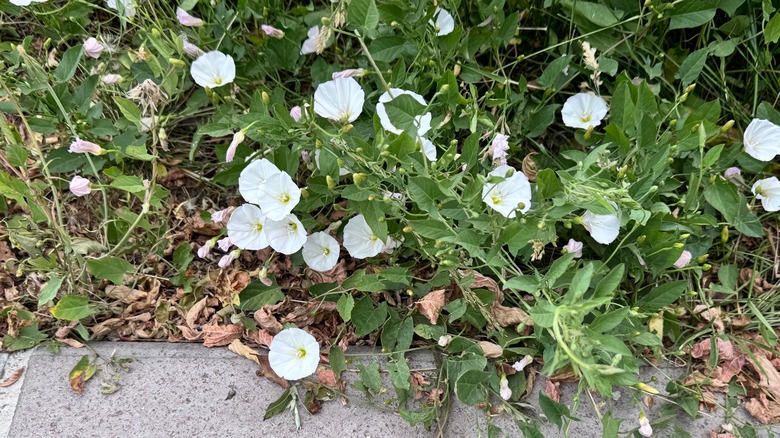The First Weed Every Gardener Should Check For After Inheriting A Yard
When you move into a newly inherited home, especially during the fall or winter months, the garden might look a little bare. While it may be easy to assume that everything is under control, as spring arrives and the flowers begin to bloom, it's likely that not everything that emerges will be welcome. Alongside flowers and fresh foliage, invasive weeds may start making an uninvited appearance.
Many weeds go dormant during the colder months, which makes them easy to miss if you move in during those seasons. But once spring rolls around and the weather warms up, they can emerge quickly and become a serious headache. One of the biggest culprits is field bindweed (Convolvulus arvensis), also known as creeping Jenny, field morningglory, and devil's guts, which is fast-spreading and notoriously hard to remove. Bindweed can remove nutrients and water from the soil, which are essential for the health of your other plants.
Luckily, fall is the best time of year to get rid of bindweed (and prevent it from growing), which is why it's smart to start looking for signs of bindweed as soon as you move in, especially if the garden hasn't been well cared for. Bindweed thrives in disturbed soil, which is common in recently inherited homes where last-minute landscaping may have unsettled the ground, making it the perfect place for this weed to take hold. So, before you start planting new beds or investing in landscaping, take the time to inspect what's already growing. Getting ahead of bindweed early on is one of the best things you can do to protect your garden's long-term health.
How to spot bindweed in your new home
Field bindweed is hardy across USDA Hardiness Zones 2 to 10 and is classified as an invasive or noxious and prohibited weed in many states. If you want to keep bindweed out of your garden, the first step is learning how to recognize it. Bindweed's flowers are deceptively delicate, usually a small white or pale pink trumpet bloom. But beneath that pretty appearance lies an extensive root system that can stretch up to 13 feet underground and that can produce a new plant even when just a fragment of the root is left behind. If you move into your new home in the fall, winter, or even spring, the key is to start scanning your yard in early spring as this is when the invasive perennial often begins to emerge. Alongside its tell-tale blooms, field bindweed also has distinctive arrow-shaped leaves that make it easier to spot.
While looking for bindweed, keep an eye out for purple loosestrife (Lythrum salicaria), as this is another common invasive species and one that can reduce food supply for native wildlife. It's most noticeable in summer thanks to its tall, spiky purple blooms, but best spotted in the cooler months before it becomes too embedded in the garden. Look for square-shaped stems, opposite leaves, and woody roots.
How to get rid of bindweed in your garden
Getting rid of bindweed can be a marathon task, but one that is worth it for the health of your garden. Once you spot it, avoid making the same mistakes everyone makes when trying to get rid of bindweed, such as relying on herbicides. The only way to get rid of bindweed for good is to remove it at its roots. Start by forking out any established plants or seedlings, ensuring you remove any roots, or pull or cut off any new growth to suppress the plant.
Smothering techniques can also help, such as covering the area with cardboard topped with a thick layer of mulch or wood chips to block sunlight and suppress growth. In lawns or open areas, frequent mowing can weaken bindweed over time. For already established flowerbeds, consider lifting out the plants you want to keep, clearing out the bindweed beneath them, and replanting. Whatever approach you take, it's important to tackle bindweed early as getting ahead of it as soon as you move in can prevent a small problem from turning into a years-long battle.


